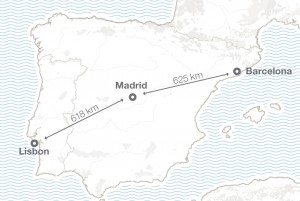With Spain dominating the Iberian Peninsula, it can be easy to overlook mighty, little Portugal. What a mistake! The country’s capital of Lisbon makes for a rewarding extra stop on any European itinerary.

Getting to Lisbon from Madrid is especially easy and inexpensive, with options to travel by bus, train or plane, most of which, falling well under $100. If you’re thinking of going on any of our Spain tours, this is one city you don’t want to skip over.
The city of Lisbon epitomizes old-world charm. Everything from the the black and white tiled sidewalks, to the yellow tram car, transports you back to another era, long before cell phones and WiFi. Don’t worry about being away from modern conveniences too much though! Lisbon also has a stellar public transit system, impressive shopping malls, and a booming nightlife. Plus, you’ll find a diverse landscape just outside of the city, with everything from relaxing beaches to picturesque forests. In just three or four days, you’ll have time to see it all!
The Alfama district is the oldest part of the city. It was the city’s cultural center when the Moors ruled the area from the 8th century until Lisbon was returned to local rule in the 12th century. Today, it is a series of narrow stairways and streets, with the melancholic sounds of traditional fado music emerging from dimly lit bars. In the afternoon, you can hop on a trolley car to bring you up to the district. From there, you can hike up to Castelo São Jorge for some breathtaking views of the city and the Tagus River. Afterward, you can take an early evening stroll through the Alfama and pop into one of the bars to see a performance. Most don’t charge entrance fees, but they will expect you to consume. Note: it’s customary in Portugal for waiters to place things like bread, cheese and olives on your table without you ordering it. If you are unsure if you will be charged for something that has been placed on your table, it’s okay to ask politely.
The district of Belém sits a little outside of central Lisbon, but it’s worth the trip. Belém is home to several of Lisbon’s iconic landmarks. First, there’s the Mosteiro dos Jerónimos, a monastery and UNESCO World Heritage site, dating back to the 15th century. Across the way, you’ll find the Torre de Belém, which was built as a lighthouse to guard entry to the port. Since Belém was the point of embarkation for explorers to the New World, you’ll also find a monument, Padrão dos Descobrimentos, that commemorates Portugal’s contributions to the discovery of lands beyond Europe.
The large monuments of Belém look out onto the 25 de Abril Bridge, reminiscent of San Francisco’s Golden Gate Bridge,as well as the large Cristo-Rei monument that keeps watch over Lisbon, much like the Cristo Redentor statue does in Rio de Janeiro, Brazil. Across the aveneue from the monuments, you’ll find a local pastry shop that has become a must-see for tourists who wish to taste the best pasteis de Belém in Lisbon. Be sure to stop in for a coffee and a plate of these delights, made up of flaky pastry dough filled with egg custard. The resteraunt supplies powdered sugar and cinnamon to sprinkle on top; try one with and one without!
The Parque das Nações is a stark contrast to the historic Alfama and Belém districts. Built for the WorldExpo, the park sits on the banks of the Tagus, within sight of the Vasco de Gama Bridge, the longest in Europe. You’ll find a large shopping mall that boasts a food court that puts many American malls to shame. Outside of the mall, you can stroll through the gardens, rent go-karts to race along the boardwalk, or take a cable car ride over the water.
Once you’ve gotten a good sense of Lisbon, it’s worth it to explore the outskirts a little. Highlights include Sintra, a Romantic-era town just under 30 kilometers from Lisbon. Sintra features several castles that have landed the town a spot on UNESCO’s list of World Heritage Sites. The Palácio Nacional da Pena is a whimsical palace that mixes a plethora of styles, colors and decor. The castle, itself, makes for a fascinating visit, but the views from its perch atop a hill are equally worth the trip. For more adventurous and active travelers, the visit can be completed with a hike from one hill to the next, where you’ll find the Castelo dos Moros, a medieval castle and fortress that dates back to the time of the Moors. Beware, the word “hill” is used very loosely here, this hike is not for the faint heart!
If you’re tired of sightseeing after your trek around Europe, be sure to end your stay with a day trip to Cascais, a seaside village that is just a short train ride from Lisbon. You’ll find small beaches tucked between large rock formations. This landscape, typical throughout Portugal’s cost, creates the illusion of secluded beaches. On a good day, you might find that you have the beach all to yourself! Top the day off with some amazing seafood at one of the many restaurants in town. Portugal is known for its fish dishes, so be sure to give one a try. My personal favorite is Polvo, or octopus, but I’ll understand if you pass on that one!
Have you been to Lisbon before? We would love to hear about your experiences and any ideas you have for exciting things to do there! Leave a comment below!
Check out our other Spain blog posts here.

